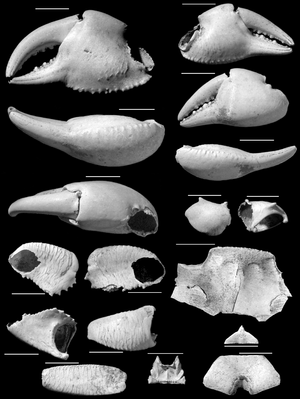Geograpsus severnsi facts for kids
Quick facts for kids Geograpsus severnsi |
|
|---|---|
 |
|
| Holotype; scale bar is 10 mm | |
| Scientific classification | |
| Kingdom: | |
| Phylum: | |
| Subphylum: | |
| Class: | |
| Order: | |
| Infraorder: | |
| Family: |
Grapsidae
|
| Genus: |
Geograpsus
|
| Species: |
G. severnsi
|
| Binomial name | |
| Geograpsus severnsi Paulay & Starmer, 2011
|
|
Geograpsus severnsi was a type of land crab that used to live in Hawaii. Sadly, it is now extinct, meaning it no longer exists. This crab died out soon after people first settled on the Hawaiian Islands. It's the first known crab to become extinct since the last Ice Age.
Contents
Where Did This Crab Live?
Scientists have found remains of Geograpsus severnsi on several Hawaiian high islands. These include Hawaiʻi, Maui, Oʻahu, and Kauaʻi. This shows the crab lived across many islands.
They found these crabs quite far from the ocean. Some remains were found up to 2 kilometers (about 1.2 miles) inland. They also lived at high places, up to 950 meters (about 3,100 feet) above sea level. This crab's living area likely overlapped with another crab, G. crinipes. That species lives closer to the coast and is found all over the Indo-Pacific region.
What Did This Crab Look Like?
Geograpsus severnsi was probably the biggest crab in its group. Its body shell, called a carapace, could be up to 66 millimeters (about 2.6 inches) wide. That's pretty big for a land crab!
Its claws were also quite large, measuring from 20 to 49 millimeters (about 0.8 to 1.9 inches) long. For all the crabs found with both claws, the right claw was always bigger. Most of the crabs found were males. This might be because of how male and female crabs behaved, not because there were many more males than females.
What Did It Eat?
Scientists believe G. severnsi lived like other land crabs. It was an omnivore, meaning it ate both plants and animals. It was also a predator. This crab likely hunted and ate insects, land snails, and even bird's eggs. In Hawaii, there are not many other crabs that live completely on land. One other species, Chiromantes obtusifrons, can move up to 50 meters (about 164 feet) inland. But it usually stays close to the water.
How Was This Crab Discovered?
G. severnsi is one of five species in the Geograpsus group of crabs. Its closest relative seems to be G. grayi. That crab is found from the western Indian Ocean to the Line Islands and Marshall Islands.
Hawaiian scientists knew about G. severnsi since the mid-1970s. However, it was not officially named and described until 2011. The crab's name, severnsi, honors Mike Severns. He was the person who found the cave where most of the crab remains were discovered.

